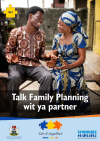Using behavior change communication to lead a comprehensive family planning program: the Nigerian Urban Reproductive Health Initiative
- PMID: 25611477
- PMCID: PMC4307859
- DOI: 10.9745/GHSP-D-14-00009
Using behavior change communication to lead a comprehensive family planning program: the Nigerian Urban Reproductive Health Initiative
Abstract
Background: The Nigerian Urban Reproductive Health Initiative (NURHI), a 6-year comprehensive family planning program (2009-2015) in 4 cities, intentionally applies communication theories to all program elements, not just the demand generation ones, relying mainly on a theory called ideation-the concept that contraceptive use is influenced by people's beliefs, ideas, and feelings and that changing these ideational factors can change people's behavior.
Program description: The project used multiple communication channels to foster dialogue about family planning, increase social approval for it, and improve accurate knowledge about contraceptives. Mobile service delivery was started in the third year to improve access to clinical methods in slums.
Methods: Data from representative baseline (2010-11) and midterm (2012) surveys of women of reproductive age in the project cities were analyzed. We also used propensity score matching to create a statistically equivalent control group of women not exposed to project activities, and we examined service delivery data from NURHI-supported clinics (January 2011-May 2013) to determine the contribution of mobile services to total family planning services.
Results: Three years into the initiative, analysis of longitudinal data shows that use of modern contraceptives has increased in each city, varying from 2.3 to 15.5 percentage points, and that the observed increases were predicted by exposure to NURHI activities. Of note is that modern method use increased substantially among the poorest wealth quintiles in project cities, on average, by 8.4 percentage points. The more project activities women were exposed to, the greater their contraceptive use. For example, among women not using a modern method at baseline, contraceptive prevalence among those with no exposure by midterm was 19.1% vs. 43.4% among those with high exposure. Project exposure had a positive dose-response relationship with ideation, as did ideation and contraceptive use. By the end of the observation period, mobile services were contributing nearly 50% of total family planning services provided through NURHI-supported clinics. Propensity score matching found that the increase in contraceptive use in the 4 cities attributable to project exposure was 9.9 percentage points. Intention to use family planning in the next 12 months also increased by 7.5 to 10.2 percentage points across the 4 cities.
Conclusion: Demand-led family planning programs, in which demand generation is the driving force behind the design rather than the conventional, service delivery-oriented approach, may be more suitable in places where expressed demand for contraceptives is low.
© Krenn et al. This is an open-access article distributed under the terms of the Creative Commons Attribution License, which permits unrestricted use, distribution, and reproduction in any medium, provided the original author and source are properly cited. To view a copy of the license, visit http://creativecommons.org/licenses/by/3.0/. When linking to this article, please use the following permanent link: http://dx.doi.org/10.9745/GHSP-D-14-00009.
Figures










References
-
- World Health Organization (WHO); World Bank; UNICEF; United Nations Population Fund. Trends in maternal mortality: 1990 to 2010: WHO, UNICEF, UNFPA and The World Bank estimates. Geneva: WHO; 2012. Available from: https://www.unfpa.org/webdav/site/global/shared/documents/publications/2...
-
- Kavanaugh ML, Anderson RM. Contraception and beyond: the health benefits of services provided at family planning centers. New York: Guttmacher Institute; 2013. Available from: http://www.guttmacher.org/pubs/health-benefits.pdf
-
- Richey C, Salem R. Elements of success in family planning programming. Popul Rep J. 2008 Sep;(57): 1–28 Available from: https://www.k4health.org/toolkits/info-publications/elements-success-fam...
-
- National Population Commission (NPC) [Nigeria]; ICF Macro. Nigeria demographic and health survey 2008. Abuja (Nigeria): NPC; 2009. Co-published by ICF Macro. Available from: http://dhsprogram.com/pubs/pdf/FR222/FR222.pdf
-
- National Population Commission [Nigeria]. Nigeria demographic and health survey 1999. Calverton (MD): ORC Macro; 2000. Co-published by the National Population Commission. Available from: http://dhsprogram.com/pubs/pdf/FR115/FR115.pdf
Publication types
MeSH terms
LinkOut - more resources
Full Text Sources
Other Literature Sources
Medical
